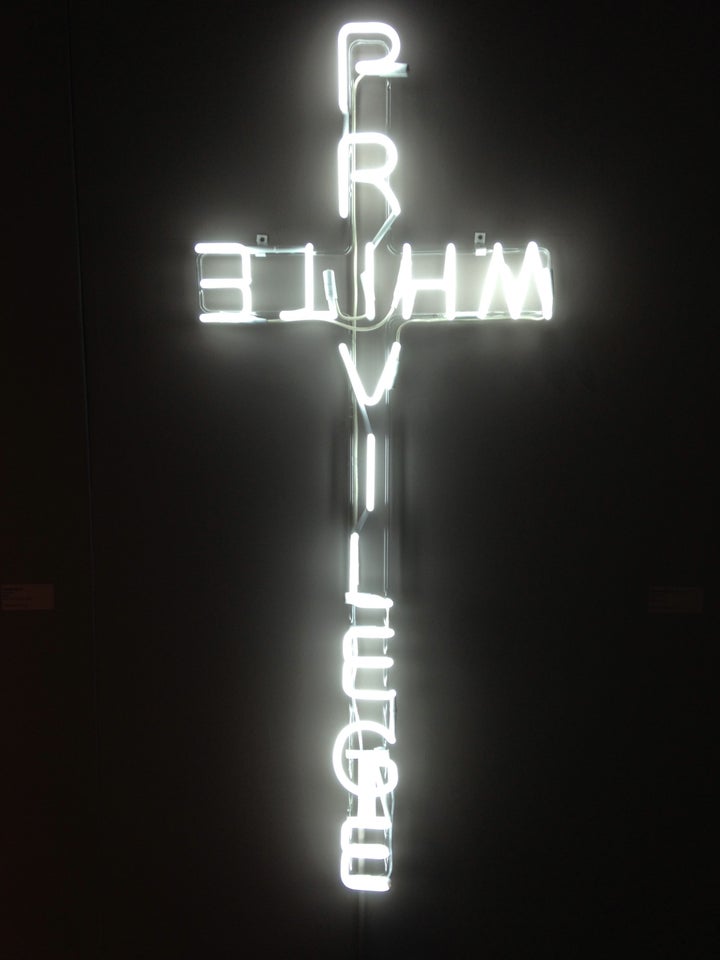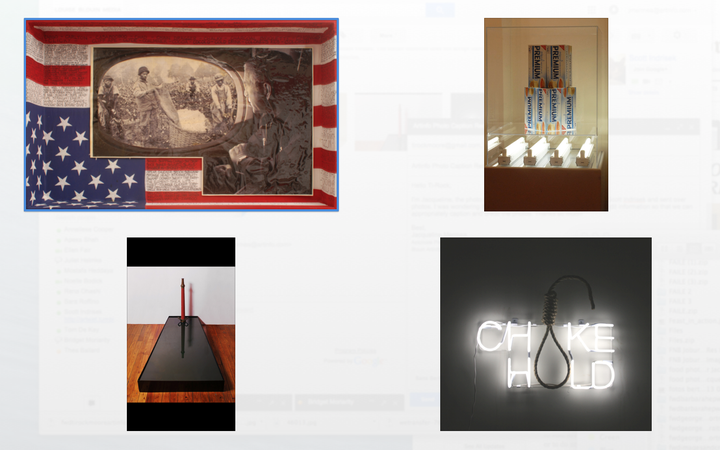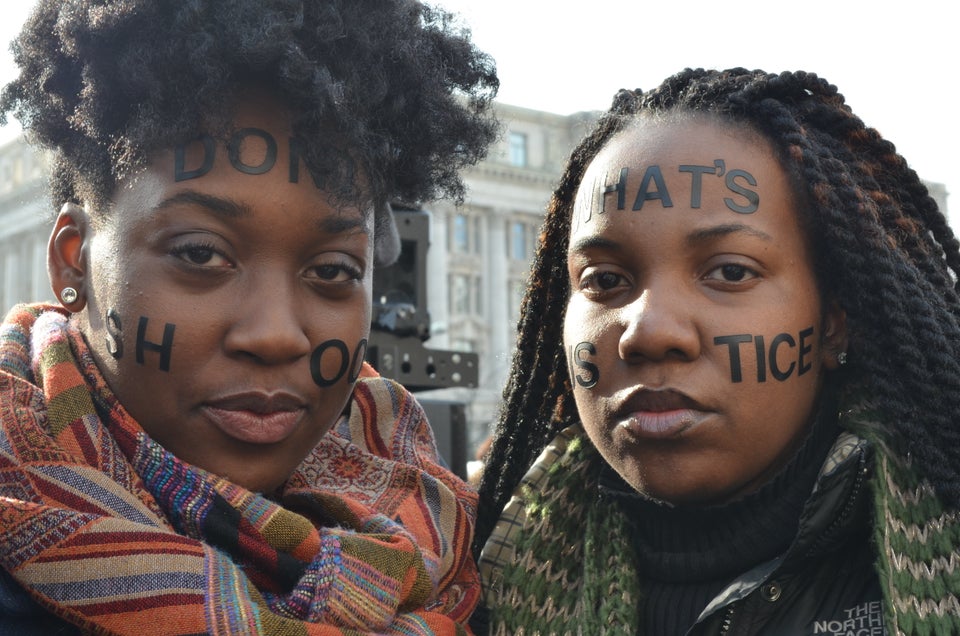Splayed on the floor of Chicago art gallery Gallery Guichard is a life-sized mannequin of Michael Brown’s dead body, face down on the ground, surrounded by police tape.
For the many Americans who have seen this image before, splashed across news programs and websites, the vision cuts deep, bringing with it the pain, grief and exasperation experienced on August 9, 2014, when the unarmed 18-year-old was shot 12 times and killed by Officer Darren Wilson.
For those who knew Brown, the unforgettable image is obviously all the more agonizing.
The sculpture is the work of Ti-Rock Moore, a white artist based in New Orleans. The piece takes center stage at Moore's current exhibition "Confronting Truths: Wake Up!" featuring 50 works revolving around notions of race and white privilege.

"Honestly and frankly," the artist explains in a statement for Gallery Guichard, "I explore white privilege through my acute awareness of the unearned advantage my white skin holds." Ironically, many are accusing Moore of exploiting her own white privilege in using the death of a black body as inspiration for her artistry.
"Despite Moore’s assertions to the contrary," Kirsten West Savali expressed in a piece on The Root, "a working definition of white privilege is white artists’ belief that they can claim artistic ownership of black death, while disowning their white guilt and being applauded for their 'courageousness.'"
In the moving piece, Savali accuses Moore of revictimizing Brown, of assuming ownership over his body and his story, when he was no longer there to protect himself.
Gallery owner Andre Guichard called the exhibition "bold and blunt," while Moore herself described it as "reactive" and "courageous." Johnetta Elzie, an activist and leader of anti-police violence group We the Protesters, preferred the terms "disgusting" and "atrocious."
The sculpture of Brown is only one of the racially charged works on view, albeit the most contentious. Another work features a confederate flag adorned with the names of the nine victims of the Charleston massacre. It sold for $4,500. According to The Guardian, the gallery plans to donate 10 percent of the money from any artwork sold to a charity aimed at ending police violence. The Michael Brown sculpture is not for sale.

This is not the first time an artist has been criticized for artwork based on Brown's death. In March, poet Kenneth Goldsmith reworded the St. Louis County autopsy report as "conceptual poetry."
"The Murdered Body of Mike Brown’s Medical Report is not our poetry," an anonymous group called the Mongrel Coalition wrote in reaction to Goldsmith. "It’s the building blocks of white supremacy, a miscreant DNA infecting everyone in the world."
These artworks beg the questions: Can a white artist successfully and meaningfully translate black suffering into a work of art? If so, can they profit off of it? We reached out to Moore to discuss her controversial piece and the decision-making process behind it.
Growing up in New Orleans, do you recall first becoming aware of your white privilege? What do those words mean to you?
It's something that I've always been quite conscious of because racial tensions are very potent in the South. But the urge to take action really struck me after Katrina, when I saw all of these displaced, predominantly black bodies laid out in front of me. Bodies I felt a deep connection to because we were all from the same place. To me, white privilege means the unearned advantages I am automatically subject to because of my skin color and that needs to end.
Obviously the death of Michael Brown caused unimaginable pain to millions of people around the country. What was your motivation to revisiting the visceral and disturbing image of Brown's dead body?
Disturbing imagery has always been used in art-making to ignite meaningful conversation. I wanted to use his death to make a statement about the brutal realities of racism in this country. I have unfortunately upset many in revisiting this tragedy, but I think the conversations that are surfacing because of it are worth noting and may help us move into a new direction.
Were you hesitant about the reception of the piece, particularly in the black community?
I was very hesitant, indeed, because I didn’t want to dishonor the family, which is why I reached out to the parents. Unfortunately, there has been a lot of miscommunication surrounding that in the media. But the family was informed and permission was granted from Michael Brown's mother.
Michael Brown's father tweeted that the piece was "disrespectful" and "inappropriate." Did you reach out to Brown's father? Were you surprised by his reaction and does it make you reconsider the piece?
I sent a letter that was addressed to both Michael Brown Sr. and Lesley McSpadden, asking for permission before I exhibited the work. Ms. McSpadden wrote back in approval and I was under the impression that the father was as well because they agreed to fly to Chicago for the opening of the exhibition to speak. I didn’t know that Mr. Brown was not on board until the night of the opening, and that I do regret.
The Root compared your piece to Kenneth Goldsmith's reading of Michael Brown's autopsy as poetry. Would you agree with this comparison?
On a surface level I understand that comparison. However, Michael Brown’s autopsy is one that contained intimate details of his body, ones that should have existed only for their intended purpose. The image of his dead body is one that is, unfortunately, already very familiar to millions in this country. By bringing this image to surface again I only intended to prompt and bring to light the very polarizing forces that continue to divide our country and that continue to isolate the black community.
Do you think the coverage of your work thus far has failed to recognize certain aspects of the piece?
Of course. What ignited this media sensation was a low-quality video of the installation that only focused on the replica of his body. There was little to no context for other very intentional and vital aspects to the work, including the audio of Eartha Kitt singing “Paint Me Black Angels” to commemorate this young man. There is also an entire body of 49 other works that should be taken into account. This exhibition is a call to action.
What did you set out to communicate through the work, and do you feel you were successful? Would you change anything about the exhibition?
We are at a very crucial time in terms of civil rights and activism in America. The work was intended to be commemorative and symbolic of crippling racism in this country. The reactions have been incredibly polarized. You have frightening pro-confederacy/white supremacist rhetoric online ... You also have black Twitter and activists devastated, claiming that I am re-victimizing this young man, and that is indeed a risk I am running and is very valid. But, my point is for us to look at what we are left with. We need to start a new conversation, and we need new discourse to move forward. It’s far too soon to make any judgments about the outcome; I’m simply looking to take one collective step forward.
This interview has been edited and condensed for clarity.

